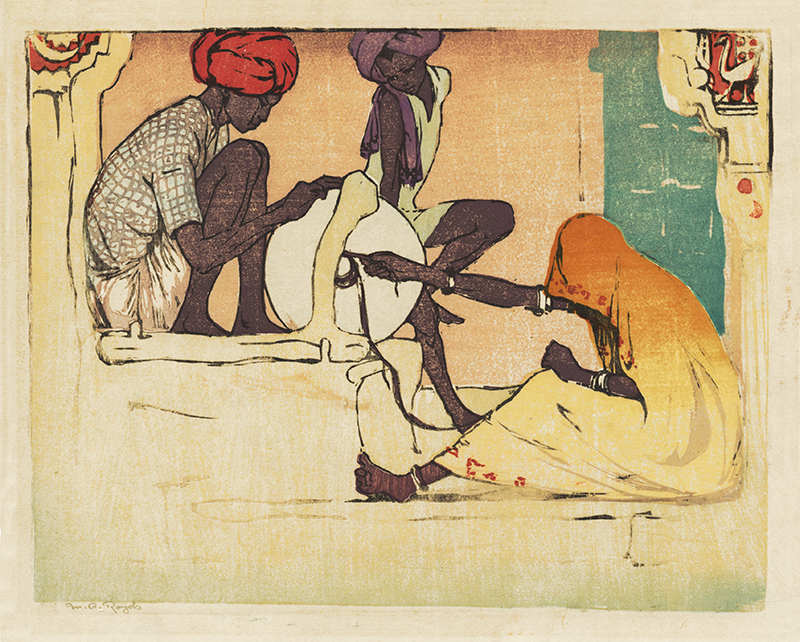
19th, 20th & 21st Century Fine Prints
707-546-7352 · fax 707-546-7924 · web: www.annexgalleries.com · email: artannex@aol.com
Knife Grinder by Mabel Allington Royds

Knife Grinder
Mabel Allington Royds
Knife Grinder
Mabel Allington Royds
1874 - 1941 (biography)By the time Mabel Royds learned the art of color woodcut she was already an accomplished painter and etcher with over three decades of experience under belt, having studied at the Slade School of Fine Arts in London beginning at age fifteen as well as private instruction in Paris and teaching art in Toronto, Canada. However, once she discovered the medium, learning from Frank Morley Fletcher after taking a position at the University of Edinburgh in 1911, it became her primary medium.
Travels to India, the Middle East, and in Tibet proved a great source of inspiration for Royds, and in “The Knife Grinder” we see the combination of her early life experience culminate in one image: the delicacy of her line; the painterly color brushed onto the block rather than rolled; the layout of the composition like a story being told, yet whose narrative is created by the viewer’s imagination.
Mabel Allington Royds was born in Bedfordshire, England, in 1874, and was raised in Liverpool. Her formal studies began at age fifteen at the Royal Academy in London on scholarship, but she soon chose to enroll instead at the Slade School of Fine Art instead, studying under Henry Tonks. Following her time there she traveled to Paris to train with printmaker Walter Sickert, and then took a teaching position at Havergal College in Toronto, Canada.
It wasn't until she had returned to the UK, settling in Edinburgh in 1911, that Royds was introduced to the medium that would become her primary focus: color woodcut. Taking a teaching position at Edinburgh College of Art, she met the influential printmaker Frank Morley Fletcher, who was then the director of the school. Fletcher taught Japanese ukiyo-e printmaking using the Western method involving a single artist, rather than the traditional Japanese three-person operation involving an artist, carver, and printer. Royds employed a unique step to her process by applying the ink onto the block with a brush rather than a roller, creating a painterly texture that rendered each impression unique. Further, she preferred to print impressions as wanted rather than print a full limited edition, making her pieces rarer still.
In 1913 Royds married fellow printmaker and teacher Ernest Lumsden. They traveled extensively throughout Europe, the Middle East, and India, and when World War I broke out Ernest joined the Indian Army, and Royds went with him to the Himalayas. These places and their inhabitants served as Royds' chief source of inspiration in the early part of her career; some remain her most well known today, including The Knife Grinder (also known as The Sword Grinder), House-Top, and The Goat Herd. Whereas many of her contemporaries were known for their sweeping landscapes and architectural prints, Royds focused on scenes of the everyday, illuminating interactions between people in situations that might otherwise seem mundane. In the 1930s she focused on botanical prints in lush, saturated colors.
Royds continued to work through the late 1930s, creating 61 color woodcuts and an unknown number of ex libris. She exhibited frequently with the Society of Scottish Artists as well as the Society of Artist Printers and the Graver Printers in Colour. She died in Edinburgh, Scotland in 1941.
